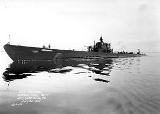
United States Porpoise class submarine
Encyclopedia
The Porpoise class were submarine
s built for the United States Navy
in the late 1930s, and incorporated a number of modern features that would make them the basis for subsequent classes such as the Salmon
, Tambor
, Gato
, Balao
, and Tench
classes. Based on the Cachalot
s, enlarged to incorporate additional main diesels and generators, the Portsmouth boats were all riveted.
In general, they were around 300 feet (91.4 m) long and diesel-electric powered. Displacement was 1,934 tons submerged for the first four boats, 1,998 tons for the later ones.
The all-electric drive was troublesome. In this arrangement, the boat's four main diesel engines drove only electric generator
s, which supplied power to electric motor
s attached to the propeller shafts. The engines themselves were not connected to the propeller
shafts. For submerged propulsion, massive storage batteries supplied electricity to the motors. Problems arose with flashover
and arcing in the main motors. There was also a loss of 360 hp in transmission through the electrical system. Their Winton Model 16-201A 16
-cylinder diesels also proved problematic, and were eventually replaced with 12-278As.
The Porpoise class consisted of the following subclasses:
P-1 Type
P-3 Type
P-5 Type
Submarine
A submarine is a watercraft capable of independent operation below the surface of the water. It differs from a submersible, which has more limited underwater capability...
s built for the United States Navy
United States Navy
The United States Navy is the naval warfare service branch of the United States Armed Forces and one of the seven uniformed services of the United States. The U.S. Navy is the largest in the world; its battle fleet tonnage is greater than that of the next 13 largest navies combined. The U.S...
in the late 1930s, and incorporated a number of modern features that would make them the basis for subsequent classes such as the Salmon
Salmon class submarine
The United States Navy Salmon-class submarines were an important developmental step in the design of the "Fleet Submarine" concept during the 1930's...
, Tambor
Tambor class submarine
The Tambor class submarine was a United States Navy submarine design, used primarily during World War II. It was the USN's first practical fleet submarine and formed the core of the United States Pacific submarine fleet at the time of the US entry into World War II.-Design history:Early U.S...
, Gato
Gato class submarine
The United States Navy Gato class submarine formed the core of the submarine service that was largely responsible for the destruction of the Japanese merchant marine and a large portion of the Imperial Japanese Navy in World War II...
, Balao
Balao class submarine
The Balao class was a successful design of United States Navy submarine used during World War II, and with 122 units built, the largest class of submarines in the United States Navy. An improvement on the earlier Gato class, the boats had slight internal differences...
, and Tench
Tench class submarine
Tench-class submarines were a type of submarine built for the United States Navy between 1944 and 1951. They were an evolutionary improvement over the Gato and Balao classes, only about 35 to 40 tons larger, but more strongly built and with a slightly improved internal layout...
classes. Based on the Cachalot
Cachalot class submarine
The Cachalot-class submarines were a pair of medium-sized submarines of the United States Navy built under the tonnage limits of the London Naval Treaty of 1930...
s, enlarged to incorporate additional main diesels and generators, the Portsmouth boats were all riveted.
In general, they were around 300 feet (91.4 m) long and diesel-electric powered. Displacement was 1,934 tons submerged for the first four boats, 1,998 tons for the later ones.
The all-electric drive was troublesome. In this arrangement, the boat's four main diesel engines drove only electric generator
Electrical generator
In electricity generation, an electric generator is a device that converts mechanical energy to electrical energy. A generator forces electric charge to flow through an external electrical circuit. It is analogous to a water pump, which causes water to flow...
s, which supplied power to electric motor
Electric motor
An electric motor converts electrical energy into mechanical energy.Most electric motors operate through the interaction of magnetic fields and current-carrying conductors to generate force...
s attached to the propeller shafts. The engines themselves were not connected to the propeller
Propeller
A propeller is a type of fan that transmits power by converting rotational motion into thrust. A pressure difference is produced between the forward and rear surfaces of the airfoil-shaped blade, and a fluid is accelerated behind the blade. Propeller dynamics can be modeled by both Bernoulli's...
shafts. For submerged propulsion, massive storage batteries supplied electricity to the motors. Problems arose with flashover
Flashover
A flashover is the near simultaneous ignition of most of the directly exposed combustible material in an enclosed area. When certain organic materials are heated they undergo thermal decomposition and release flammable gases...
and arcing in the main motors. There was also a loss of 360 hp in transmission through the electrical system. Their Winton Model 16-201A 16
V16 engine
A V16 engine is a V engine with 16 cylinders. Engines of this number of cylinders are uncommon in automotive use.A V16 engine is perfectly balanced regardless of the V angle without requiring counter-rotating balancing shafts which are necessary to balance Straight-4 and odd number of cylinder...
-cylinder diesels also proved problematic, and were eventually replaced with 12-278As.
The Porpoise class consisted of the following subclasses:
P-1 Type
- (SS-172)
- (SS-173)
P-3 Type
- (SS-174)
- (SS-175)
P-5 Type
- (SS-176)
- (SS-177)
- (SS-178)
- (SS-179)
- (SS-180)
- (SS-181)

